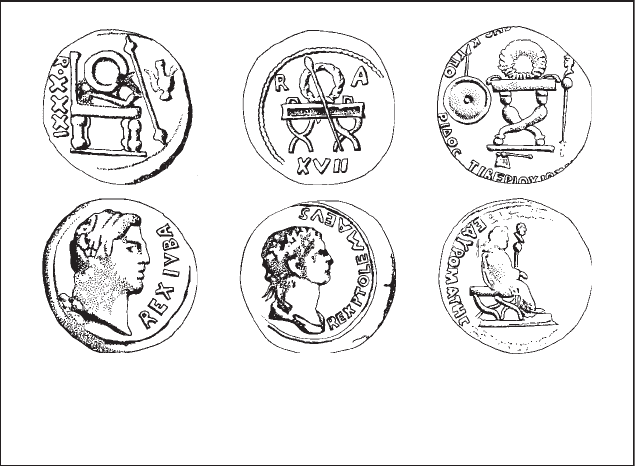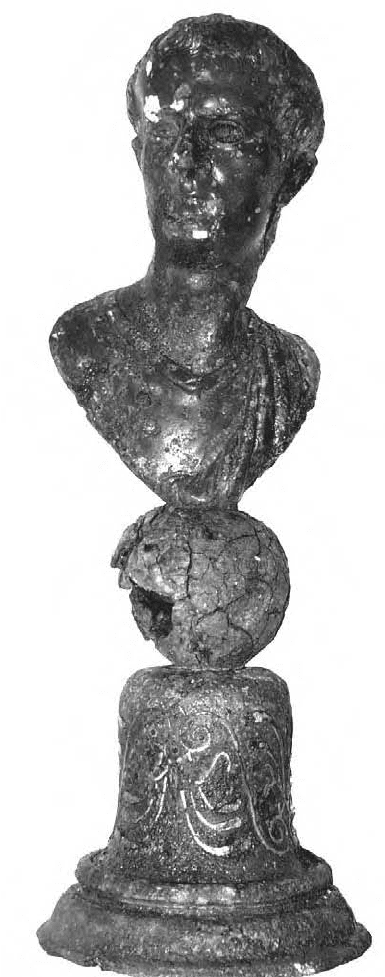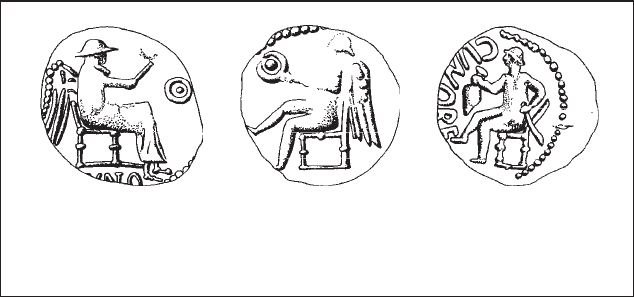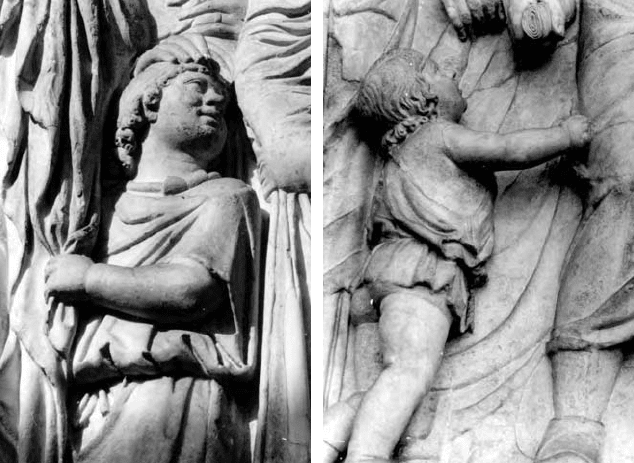Creighton J. Britannia. The creation of a Roman province
Подождите немного. Документ загружается.


38
identi fi cation is by no means secure, and referring to it just as early Julio-
Claudian is probably safest. In terms of visual language the representation
of the emperor’s head on a globe showing world domination is an image
redolent of power (Nicolet 1991: 36–7). The globe appears on denarii asso-
ciated with Caesar (RRC 494/39a; 480/6); it could be seen being trampled
underfoot by both the fi gure of Roma (RRC 449/4) and Victory herself
(RRC 546/4). The message in each case was the same: Rome was supreme.
As a gift to a friendly king, the image of an imperial bust on a globe linked
the king with his distant but omnipresent sponsor and guarantor. It clearly
demonstrated where power lay to back up the king in his kingdom.
Evidence for chairs, and a sella curulis in particular, has been found in the
Lexden tumulus in Camulodunum. Within this high-status grave, dating to
some time around 15–1 BC, a large amount of corroded ironwork was found
which Foster (1986: 61, 109) identifi ed plausibly as part of a folding chair.
The identifi cation is not absolutely certain; none the less it offers the most
convincing interpretation of the remains, and in the light of the discussion
above is by no means unlikely. Together with it was found a small sandalled
foot, which may have been on one of the legs, as paralleled in an example
from a Claudian burial in Nijmegen (Jitta et al. 1973).
Another piece of furniture came from the Folly Lane burial over looking
THE TRAPPINGS OF POWER
Mauretania
Juba II
(Mazard 195)
Mauretania
Ptolemy
(Mazard 399)
Bosporan Kingdom
Top: Rhescuporis II
Bottom: Sauromates I
Figure 2.1 Representation of regalia on the coinage of friendly kingdoms

39
THE TRAPPINGS OF POWER
Figure 2.2 Bust identifi ed as Gaius, found near Colchester in the nineteenth century
(photo: © Colchester Museums)

Verulamium (Niblett 1999). This high-status burial dates to some time
around or just after the Claudian annexation. Selected remains from the
funerary pyre were thrown back into the burial chamber; amongst these were
several lathe-turned pieces of ivory, a bronze foot and an iron shank. These
potentially came from the leg of a chair or a couch, where the ivory discs
fi tted over an iron rod that gave rigidity to the leg. In this case there was a
preference for interpreting the remains as being from a couch, since it would
be possible to imagine the corpse laid out on it in the funerary chamber (cf.
Pearson’s reconstruction: Figure 7.9). A survey of other couches showed
that comparable examples came from the fi rst century BC and the earlier
part of the fi rst century AD, in which case the Folly Lane piece would be at
the tail-end of the series, but not impossible (Nicholas 1979, 1991), though
appearing to be almost ‘antique’ Augustan furniture by that date. However,
there is the possibility that it is not a couch at all. The ivory knobs in the
Folly Lane burial create a strong resonance with a series of images on some
of Cunobelin’s coins. Cunobelin never issued types displaying gifts in the
same way as Ptolomy, Juba II and other kings, but he did mint several which
depicted a chair in which either he or Victory sat. The legs of the chair
clearly have knobs on, in the same fashion as the ivory pieces from Folly
Lane (Figure 2.3).
Two of these coins show what appears to be winged Victory sitting in
the chair. They are related to a Roman type (RRC 343/1), but are not direct
copies. In one she is holding a short rod or sceptre, whilst in the other she
is clasping a dot-in-ring motif, which may represent a torc, patera or wreath.
There is a third coin that is clearly part of the same set of images. This one
has a male seated on an identical ‘chair with knobs on’ and he has his right
foot raised slightly in the air, just as ‘Victory’ does on one of the others.
THE TRAPPINGS OF POWER
40
Cunobelin
(VA2045:E8)
Cunobelin
(VA1971:E8)
Cunobelin
(ICC94.0995:E8)
Figure 2.3 Coins of Cunobelin and Victory on chairs
41
However, instead of holding a sceptre or torc (two clear symbols of author-
ity), he is carrying a sword in one hand and an amphora in the other. On
all these images Cunobelin’s name is plainly inscribed. Together these coins
clearly display the accoutrements of power, and the interchangeability of this
fi gure and Cunobelin is directly paralleled in the way Augustus himself used
the image of Victory:
Inside the curia . . . Octavian set up the original statue of Victory,
an Early Hellenistic work which came from Tarrentum, and she was
regarded as his personal patron goddess. Probably Octavian at fi rst
had it mounted on a globe, the symbol of his claim to sole power,
but [after Actium] the goddess was given Egyptian booty (in the
form of captured weapons) in her hand and was set atop a pillar at
the most conspicuous spot in the council chamber, behind the seats
of the consuls. From now on she would be present at every meeting
of the Senate.
(Zanker 1988: 79–80)
The coin images suggest that Cunobelin represented himself using a strategy
similar to Augustus, employing the fi gure of a deity to stand in for his pres-
ence. Had an ivory throne been a gift to the kings of the Eastern Dynasty, it
is not surprising that it might have been ceremonially destroyed in the burial
at Folly Lane, which may well have been that of the last friendly king of
the region. Future governors would require a sella curulis, not a high-backed
throne.
Other survivals from Lexden included some thin fi laments of gold ribbon,
which had been wound round some form of textile (Foster 1986: 92). A par-
allel for this thread comes from the supposed grave of Philip of Macedon
at Vergina (Andronikos 1978: 66; Fitzpatrick 1989: 406); here the gold was
woven with purple into a series of fl oral and fi gural motifs. Alas, no evidence
like that survives from Lexden. Exactly what the textile came from is open to
speculation. It could have been from soft furnishings from the folding chair
or couch in the burial, or it could have been from a garment, possibly even
a toga picta. Also from the grave was some silver in the form of what Foster
(1986: 88) described as stylised wheat or cereal stems, which could also have
been sewn onto a fabric backing. The description as wheat is tempting as it
is a constant leitmotif on a lot of the region’s later coinage under Cunobelin.
However, since the stems curve, and since the ‘grains’ are set opposed to
each other rather than alternately, I think an interpretation of them as laurel
branches is more likely; again a clear symbol of status. Many other objects
were found in the grave, which could have been gifts, but the most evocative
is the silver medallion of Augustus himself (Figure 2.4). The bust is of the
same type as was found on the coinage of around 18–16 BC, only shortly
before the suspected date of the grave (15–1 BC).
THE TRAPPINGS OF POWER

42
Another collection of objects, which may have been gifts from Rome, is
the fi nd of gold jewellery from near Winchester in 2000 (Figure 2.5; Pitts
2001; Hill et al. 2004). Metal detection on a hillside that had otherwise pro-
duced no signs of settlement revealed two torcs, two bracelets and two
pairs of fastening brooches with a linking chain. The brooches were golden
copies of Knotenfi beln, a late La Tène design dating from around 80–30 BC.
The choice of the two pairs of gold brooches is redolent of the gift given
to Masinissa, where they were accompanied by two purple cloaks (Liv.
30.17.13). These La Tène style artefacts hardly seem like the kind of object
which might be an imperial gift given to a British leader, but the golden torcs
associated with them were exceptional. Whereas torcs per se are a common
feature of the Late Iron Age, particularly in areas such as Norfolk, these
ones were made using a technique and an alloy that were both very alien and
associated with an origin in the Mediterranean world. They were made from
a series of interlocked loops of gold to create a fl exible snake-like cord. The
manufacturing technique was hitherto unknown in Britain and suggested
infl uence from the classical world in its design. This idea was reinforced
Figure 2.4 Silver medallion of Augustus from the Lexden tumulus, Colchester (photo:
© Colchester Museums)
THE TRAPPINGS OF POWER

43
THE TRAPPINGS OF POWER
Figure 2.5 The Winchester hoard (photo: © Copyright The British Museum)

by the metallurgical analysis that showed they had been made from highly
refi ned gold, again suggesting a Mediterranean origin. A Mediterranean-
designed torc in northern Europe may appear a curiosity, but the importance
of the symbolism of the torc was clearly understood in Rome. On Augustus’
Ara Pacis itself we can see an image of two children in the procession with
Augustus, both thought to represent obsides, and both wearing torcs round
their necks (Figure 2.6; Rose 1990). Such a gift would seem entirely appropri-
ate to a returning British prince coming home, representing both northern
European symbolism and Roman power and technology. The dating of the
fi nd is problematic since it was found in isolation, while its interpretation is
always going to be more challenging than material clearly contextualised in a
rich burial, but the possibility remains that it was an early high-status gift to
one of the Commian dynasty or someone of that genre.
The objects from Folly Lane, Lexden and elsewhere, when considered
together, make up a small but signifi cant assemblage of highly symbolic
material culture from the Roman world.
We have two ways of interpreting these objects: either as gifts from Rome,
through which the British kings and their families demonstrated their asso-
ciation with the Princeps; or else as direct imitations of the insignia of the
THE TRAPPINGS OF POWER
44
Figure 2.6 Two children on the Ara Pacis wearing torcs. Left, eastern ‘prince’ from
the south frieze; right, western ‘prince’ from the north frieze (Photo:
© Ray Laurence)
45
elite of the Roman world. Just as we cannot be sure that the regalia displayed
on Juba II and Bosporan coinage were gifts from Rome, these rulers none
the less appeared to have objects which emulated the symbols of Roman
authority.
This blurring of regalia between kings and the subsequent Roman gov-
ernors would have made for relatively easy continuity between one and the
other. Indeed in terms of direct presence and representation, one wonders
exactly how a British audience would have perceived the differences between
Cunobelin or Cogidubnus and a Roman governor. After all, the insignia
would have been comparable; if both had been raised in Rome their
upbringing and education may have rendered their bodily dispositions simi-
lar; their use of imagery would be alike; and their judicial authority over all
but Roman citizens would have been comparable. In terms of the regalia of
power in the southeast, the signifi cance of AD 43 or the death of Cogidub-
nus may have been negligible.
Governors and kings were born of the same stock, forceful and ambitious
men who desired power. In the Republic senators could borrow money to
bribe, lobby and secure for themselves a province to govern; once in posi-
tion, that position could be exploited to make a fortune to retire on, to pay
back the loans and if need be pay to ensure an acquittal at a trial for abuse
of power. Braund suggests kings were little different, many borrowing large
sums of money to secure recognition, aiming to pay it back once the rich
pickings of rule were theirs (e.g. Auletes borrowing money from Pompey
and Caesar amongst others to seek ratifi cation of the throne in Egypt, and
thereafter draining his kingdom dry: Braund 1984: 59). Kings and governors
were not so different; both sets of men were cut from the same cloth.
THE TRAPPINGS OF POWER
46
3
FORCE, VIOLENCE AND THE
CONQUEST
A king, being given title to a kingdom by Rome and all the trappings of
power to go with it, is all very well, but it is of nought unless the monarch
has the ability to resort to the ultimate sanction of force to back up his claim.
Violence, or the threat of violence, cannot have been far from the surface
as the Commian and Tasciovanian dynasties secured their dominion over
the populace of the southeast. Killing people was certainly one method of
getting rid of political dissent, but a far more profi table way was slavery, a
product that Strabo attests was exported from Britain in the Augustan period
(Strab. Geog. 4.5.1). But what did institutional violence look like in Late Iron
Age Britain? Were these kings supported in their role by a chariot-riding
woad-painted militia, complete with lime-washed hair and swirling tattoos;
or did this institution of ‘friends and allies of Rome’ lead to changes in the
appearance and articulation of institutionalised violence?
Kingdoms or republics that exist in the shadow of empires or super powers
can often rely upon ‘support’ from their more powerful allies who have
a vested interest in their stability. That support can take a wide variety of
forms: foreigners might be trained at imperial army colleges alongside other
soldiers; arms sales might equip them in a similar manner to the imperial
troops; military advisers might visit the kingdoms to assist in local training on
the ground; or direct assistance might be given to prop up a regime which for
whatever reason the local populace have turned against. None of these phe-
nomena are remotely unusual in the modern day; nor were they in the Roman
world. We have seen how the symbolism of Roman power and authority was
adopted in the kingdoms of the southeast, and also how these individuals
were intrinsically tied up in the political structure of the Principate. Rome
had an investment in these kingdoms, and that investment worked not just
on the level of treaties, but in terms of military engagement as well.
The clearest icons of Roman power were, of course, the legions and auxilia.
In the traditional representation of Roman Britain, the arrival of the army
marks the difference between Iron Age and Roman Britain. AD 43 is the key
date at which the transition is perceived as taking place; and yet this did not
mark the end of kingship in Britain, nor was it the date when the civitates were
47
probably formally constituted; but it is when the Claudian legions landed. In
this sense, AD 43 appears to mark a signifi cant change in the articulation of
power in Britain. However, again I think that the authority of a precise histor-
ical date and event is obscuring a much broader continuum of change. Indeed
I believe that ‘Roman’ troops may have been present in Britain for a while
before, but because of our fi xation with one particular reading of history, we
have blinded ourselves to the archaeological evidence that may indicate this.
It is not that we have rejected such suggestions; it is that we have never even
considered them.
Knowledge of Roman military matters and the use of force would have
been relatively well understood in southeast Britain in the early fi rst century
AD. Part of this would have been historical, the memory of Caesar’s con-
quest. However, in Gaul many of the warriors of the defeated and allied
communities went on to fi ght as auxiliary units in the civil wars that engulfed
the Roman world. If Gauls had gone to fi ght, it is more than likely that some
Britons had as well; if so, many back in Britain could have had direct experi-
ence of fi ghting against and alongside Roman troops. None the less, what I
am interested in here is not just the memory of individual life experiences in
Britain, but the articulation of power, which means examining the mindset of
the ruling individuals, and how they implemented force. Again we must recall
the range of experiences to which obsides were exposed, and then consider
if the archaeological evidence in Britain offers any support for the notion
that British ‘royalty’ shows signs of having been treated in the same way.
Many obsides spent time not just in Rome, but also with the Roman army
on campaign. This was a learning experience which some of them turned
to their own advantage years later. One such was Jugurtha, the illegitimate
nephew of Micipsa, King of Numidia. In his own kingdom he was over-
shadowing Micipsa’s own two sons, so he was sent away. In this case he
went, with a Numidian contingent, to assist Scipio Aemilianus in his siege
of Numantia in northwest Spain. Here he proved his capabilities, won much
admiration and even learnt Latin (Sall. BJ 7); but more importantly, he learnt
the art of war. So impressive were his achievements that he became Micipsa’s
heir. Upon fi nally becoming king he also put this learning experience into
effect when circumstances drew him into confl ict with Rome herself, during
which he proved a formidable enemy, knowing and understanding Roman
strategy. We know more about Jugurtha than anyone else since an entire
volume about the wars survives for us written by Sallust. However, remarks
about other obsides’ adventures with the Roman army are scarce, as they are
usually only inconsequential asides in narratives fulfi lling another purpose.
Juba II of Mauretania served in various campaigns during his youth with
Octavian; however this is only learnt from a passing comment in a history
summing up what happened to all the children of Cleopatra, since Juba was
married to one of her daughters as a reward for his service (Dio 51.15.6).
Another foreigner engaged in the Roman army was the Parthian Ornospades.
FORCE, VIOLENCE AND THE CONQUEST
